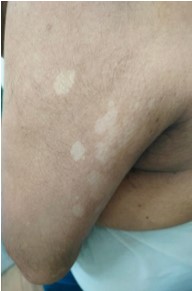A clinical evaluation of Bakuchi Hartal Lepa and Amalaki Khadir Kashayam in the management of Switra (Vitiligo) - A Pilot Study
DOI:
https://doi.org/10.21760/jaims.8.9.7Keywords:
Vitiligo, Switra, Kushtha Roga, Amalaki-Khadir Kashaya, BakuchiAbstract
Vitiligo is usually patchy depigmentary disorder, due to reduced or absent melanocytes. Most paediatric cases present after first decade of life with well-demarcated milky-white or hypopigmented patches. In Ayurveda vitiligo is known as Shwitra and described under Kushtha. The Tridoshas (Vata, Pitta, and Kapha) and Dhatus (such as Rasa, Rakta, Mamsa, and Meda) vitiations are what give rise to this variety of Kushta in the classical Ayurvedic texts. The disease is significant primarily because it raises cosmetic concerns, which ultimately cause the sufferer to experience several socialised psychological stigmas. Ayurveda provide effective and safe treatment protocol for vitiligo. In the present Pilot study Amalaki- Khadir Kashaya with Bakuchi (Prakshep Dravya) is used as internal medication and Bakuchi, Hartala Lepa with Gomutra as external therapy in 8 patients. The Gunas of these drugs are opposite to Doshas responsible for Switra. This study shows significant decrease in number of hypopigmented patch as well as improvement in the psychological status of the patient.
Downloads
References
Yadavaji Trikamji Acharya ed, Charaka Samhita Chikitsa 8/166, 172-176 1st ed, reprint 2008, Chaukhamba Subharti prakashan, Varanasi pp 458.
Alikhan A, Felsten LM, Daly M, Petronic-Rosic V. Vitiligo: a comprehensive overview Part I. Introduction, epidemiology, quality of life, diagnosis, differential diagnosis, associations, histopathology, etiology, and work-up. J Am Acad Dermatol. 2011;65(3):473–91. doi:10.1016/j.jaad.2010.11.061
Shah H, Mehta A, Astik B. Clinical and sociodemographic study of vitiligo. Indian J Dermatol Venereol Leprol. 2008;74(6):701. doi:10.4103/0378-6323.45144.
Glenmark Mediworld – 1991, July – Sept – Vol-119, Issue-3
Yadavaji Trikamji Acharya ed, Charaka Samhita Chikitsa 8/166, 172-176 1st ed, reprint 2008, Chaukhamba Subharti Prakashan, Varanasi pp 458.
Yadavaji Trikamji Acharya ed, Charaka Samhita Chikitsa 8/166, 172-176 1st ed, reprint 2008, Chaukhamba Subharti prakashan, Varanasi pp 458.
Bhava Prakasha of Sri Bhavamishra by Brahmasankara Mishra and Rupalalji Vaisya. Part 1, 11th ed. Varanasi, Chowkamba Sanskrit Series; Bakuchi, Haritakyadi Varga. 2002. p.123‐4.
Ajay Dhanik, N. Sujatha, N. P. Rai. Clinical evaluation of the efficacy of Shwitrahara kashaya and lepa in vitiligo, AYU | Jan-Mar 2011 | Vol 32 | Issue 1
Michel L, Dupuy A, Jean‐Louis F, Sors A, Poupon J, Viguier M, et al. Arsenic trioxide induces apoptosis of cutaneous T cell lymphoma cells: Evidence for a partially caspase‐independent pathway and potentiation by ascorbic acid (vitamin C). J Invest Dermatol 2003;121:881‐93.
Ajay Dhanik, N. Sujatha, N. P. Rai. Clinical evaluation of the efficacy of Shwitrahara kashaya and lepa in vitiligo, AYU | Jan-Mar 2011 | Vol 32 | Issue 1
Sushruta, Sushruta Samhita with commentary of Dalhana, by Vaidya Judaea JI Trikamji Acharya, Chaukhambha Orientale; Varanasi: 2002. 7th ed. Sutra Sthana 45/194. pg.211.
Sushruta Sutra Sthana 11/74-75
Bhavaprakash Nigthantu
Rasa Tarngini 14-71















